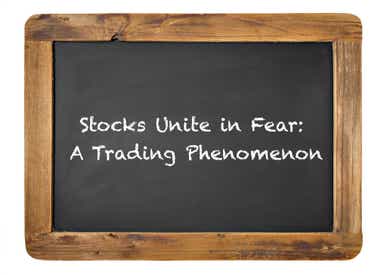Stocks Unite in Fear: A Trading Phenomenon

Stocks Unite in Fear: A Trading Phenomenon
By:Kai Zeng
Do stocks generally show stronger correlations and move more in sync during periods of uncertainty?
- Market corrections aren't random.
- Do stocks really show stronger correlations during corrections?
- VIX can help decipher connections in stock performance.
When the stock market experiences a downturn, often termed a market correction, it is not merely a sequence of random fluctuations.
The prevalent market belief is that stocks generally show stronger correlations and move more in sync during periods of uncertainty. But what does historical data say about this? For traders keen on efficiently managing portfolio risks in times of market distress, understanding this behavior is crucial. Let's delve into historical data to test the validity of this hypothesis.
A key tool in deciphering these connections is the CBOE Volatility Index (VIX), commonly known as the market's “fear index.” For example, during high VIX periods, signaling considerable fear or uncertainty, companies like Nvidia (NVDA) and broader market indices such as the S&P 500 ETF (SPY), tend to align more closely.
Typically, NVDA and SPY have a moderate positive correlation of 0.56.
.png?format=pjpg&auto=webp&quality=50&width=1000&disable=upscale)
NVDA/SPY correlation during turmoil
However, this correlation climbs notably during market turmoil compared to calmer periods.
_(1).png?format=pjpg&auto=webp&quality=50&width=1000&disable=upscale)
This pattern of stocks moving together isn’t just seen in individual stocks but across different sectors of the economy.
Technology companies like Apple (AAPL), energy entities represented by the Energy ETF (XLE) and retail behemoths such as Costco Wholesale (COST), all exhibit this pattern. Normally, their correlations are modest, yet during volatile market phases, they intensify remarkably.
The correlation among these diverse sectors or their representatives sharpens to an average of 0.84, transforming from moderate to strongly positive.
_(2).png?format=pjpg&auto=webp&quality=50&width=1000&disable=upscale)
Corrections negate diversification
The increasing similarity in movements among different stocks and sectors during high volatility challenges the conventional strategy of investment diversification—the practice of spreading investments to manage risk. In essence, when everything declines simultaneously, the benefits of diversification are negated.
In such scenarios, ironically, reducing overall market exposure may prove to be more effective than employing complex trading strategies like hedging with additional positions, which could introduce further risks due to these synchronized market movements.
Recognizing how stocks are interconnected during varying market conditions is essential, not only for traders but for anyone interested in making well-informed investment decisions amid uncertainties. By examining these relationships, investors can devise more effective strategies to manage and navigate through these turbulent times.
Kai Zeng, director of the research team and head of Chinese content at tastylive, has 20 years of experience in markets and derivatives trading. He cohosts several live shows, including From Theory to Practice and Building Blocks. @kai_zeng1
For live daily programming, market news and commentary, visit tastylive or the YouTube channels tastylive (for options traders), and tastyliveTrending for stocks, futures, forex & macro.
Trade with a better broker, open a tastytrade account today. tastylive, Inc. and tastytrade, Inc. are separate but affiliated companies.
Options involve risk and are not suitable for all investors. Please read Characteristics and Risks of Standardized Options before deciding to invest in options.